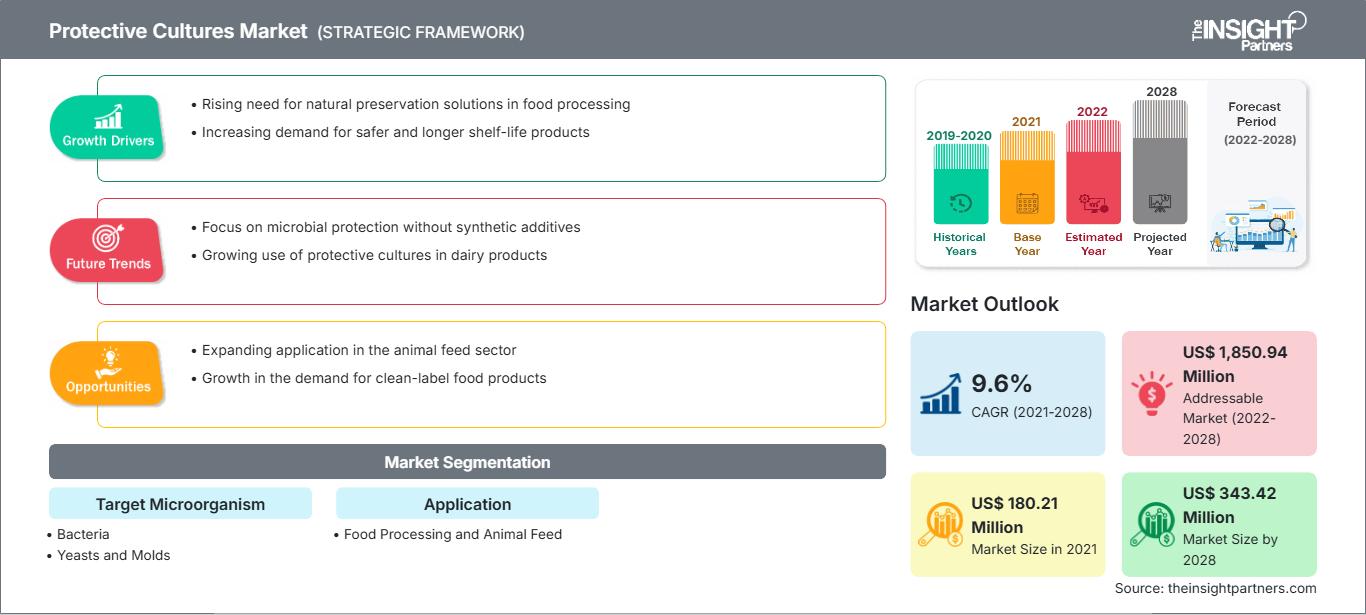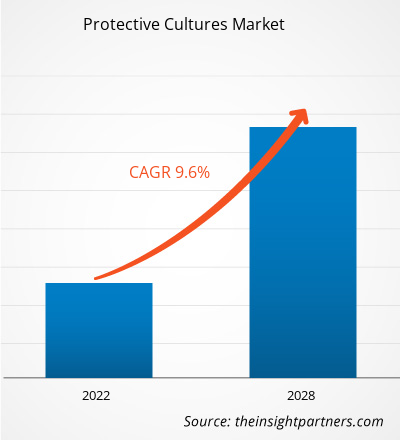[Forschungsbericht]Der Markt für Schutzkulturen wird voraussichtlich von 180,21 Millionen US-Dollar im Jahr 2021 auf 343,42 Millionen US-Dollar im Jahr 2028 wachsen; von 2021 bis 2028 wird ein CAGR-Wachstum von schätzungsweise 9,6 % erwartet.
Die steigende Nachfrage nach natürlichen und chemisch konservierungsmittelfreien Produkten und die wachsende Nachfrage nach verderblichen Produkten mit längerer Haltbarkeit weltweit treiben das Wachstum des Marktes für Schutzkulturen voran.
Der Markt für Schutzkulturen im asiatisch-pazifischen Raum wird im Prognosezeitraum voraussichtlich das höchste CAGR-Wachstum aufweisen. China ist der wichtigste Markt für Milchprodukte und wird hauptsächlich durch den steigenden Konsum von Milchprodukten angetrieben. Die steigende Nachfrage nach Milchprodukten wie natürlichen Snacks, fermentierten Milchprodukten wie Sauermilch und Joghurt sowie Produkt- und Verpackungsinnovationen treibt das Wachstum des Marktes für Milchprodukte im asiatisch-pazifischen Raum voran. Daher wird erwartet, dass der Markt für Schutzkulturen in den kommenden Jahren aufgrund des steigenden Konsums von Milchprodukten und der Vorteile von Schutzkulturen, wie der Fähigkeit, das Wachstum pathogener und verderblicher Mikroorganismen zu hemmen, deutlich wachsen wird. Darüber hinaus trägt das zunehmende Bewusstsein der asiatischen Bevölkerung für natürliche und Clean-Label-Produkte zur Marktexpansion bei.
Passen Sie diesen Bericht Ihren Anforderungen an
Sie erhalten kostenlos Anpassungen an jedem Bericht, einschließlich Teilen dieses Berichts oder einer Analyse auf Länderebene, eines Excel-Datenpakets sowie tolle Angebote und Rabatte für Start-ups und Universitäten.
Markt für Schutzkulturen: Strategische Einblicke

- Holen Sie sich die wichtigsten Markttrends aus diesem Bericht.Dieses KOSTENLOSE Beispiel umfasst Datenanalysen, die von Markttrends bis hin zu Schätzungen und Prognosen reichen.
Sie erhalten kostenlos Anpassungen an jedem Bericht, einschließlich Teilen dieses Berichts oder einer Analyse auf Länderebene, eines Excel-Datenpakets sowie tolle Angebote und Rabatte für Start-ups und Universitäten.
Markt für Schutzkulturen: Strategische Einblicke

- Holen Sie sich die wichtigsten Markttrends aus diesem Bericht.Dieses KOSTENLOSE Beispiel umfasst Datenanalysen, die von Markttrends bis hin zu Schätzungen und Prognosen reichen.
Auswirkungen der COVID-19-Pandemie auf den Markt für Schutzkulturen
Die anhaltende COVID-19-Pandemie hatte relativ positive Auswirkungen auf den Markt für Schutzkulturen. Die Pandemie trug dazu bei, ein Interesse und ein Bewusstsein für mikrobielle Kulturen zu entwickeln. Die Krise war für den Großteil der Weltbevölkerung eine unangenehme und stressige Zeit. Daher haben die Menschen weltweit begonnen, Clean-Label-Produkte zu konsumieren. Nach dem Ausbruch der COVID-19-Pandemie sind die Menschen im Umgang mit Lebensmitteln vorsichtiger geworden und ernähren sich gesünder als üblich. Die COVID-19-Pandemie hat die Wahrnehmung von Sauberkeit durch die Verbraucher über Etiketten oder Produkte hinaus verändert. Verbraucher legen weiterhin Wert auf Clean Label für Einkäufe zu Hause und außer Haus, was die Anwendung von Clean Label in den verschiedenen Lebensmittelanwendungen verstärkt. Darüber hinaus sind die Aussichten für den wirtschaftlichen Fortschritt in den meisten Ländern für 2021 optimistisch.
Markteinblicke
Steigender Konsum von Milchprodukten
Der Milchmarkt entwickelt sich weltweit weiter. Verbraucher bevorzugen gesündere, natürliche und nachhaltige Milchprodukte mit kürzeren Zutatenlisten und mehr Transparenz bei der Produktkennzeichnung. Mit dem zunehmend geschäftigen modernen Lebensstil steigt die Nachfrage nach praktischen Optionen, die unterwegs verzehrt werden können, ohne gekühlt werden zu müssen, um frisch zu bleiben. Schutzkulturen sind wichtig, um Milchherstellern zu helfen, ihren Gewinn zu steigern, indem sie Verderb während der gesamten Haltbarkeitsdauer vermeiden und so den Verbraucherwunsch nach natürlichen und Clean-Label-Produkten erfüllen. Darüber hinaus steigt der Konsum von Milchprodukten wie Joghurt, Butter und Käse weltweit stark an.
Käse ist weltweit zu einem Hauptbestandteil der täglichen Ernährung geworden. Nach Angaben des US-Landwirtschaftsministeriums wurden im Jahr 2017 in den USA 5.733 Tonnen Käse produziert, und die Menschen in Nordamerika konsumieren jährlich durchschnittlich etwa 6.626 Tonnen Käse. Der Käsemarkt ist aufgrund der speziellen Schutzkultur gegen Listerien auch einer der Hauptabnehmer von Schutzkulturen. Diese wird aus Lactobacillus plantarum hergestellt und verhindert wirksam die Bildung von Listerien auf den oberflächengereiften Käsesorten mit hohem Risiko für Rotschmiere. Diese genannten Faktoren treiben die Nachfrage nach Käse auf dem Markt für Schutzkulturen voran. Darüber hinaus sind Unternehmen wie DuPont Danisco und Chr Hansen mit umfangreichen Schutzkulturen für Milchprodukte stark auf dem Markt für Milchprodukte vertreten. Mit der steigenden Nachfrage nach natürlichen und gesunden Milchprodukten erfreuen sich Clean-Label- und Green-Label-Produkte in der Milchindustrie einer enormen Nachfrage.
Erkenntnisse zu Zielmikroorganismen
Basierend auf den Zielmikroorganismen ist der Markt für Schutzkulturen in Bakterien sowie Hefen und Schimmelpilze unterteilt. Das Segment Hefen und Schimmelpilze hatte 2020 einen größeren Marktanteil. Hefen sind eine Untergruppe der Pilze, einer großen Gruppe von Organismen, zu der auch Schimmelpilze und Champignons gehören. Sie sind typischerweise einzellige Organismen, die sich entwickelt haben, um in einer speziellen Umgebung zu leben. Hefe besiedelt typischerweise stark salz- oder zuckerhaltige Lebensmittel wie Essiggurken, Ahornsirup und andere, was zu deren Verderb beiträgt. Früchte und Flüssigkeiten mit einem niedrigen pH-Wert sind weitere Ziele, und es gibt Hefen, die sich auf der Oberfläche von Fleisch und Käse entwickeln. Schimmelpilze bestehen aus Millionen mikroskopisch kleiner Zellen, die zu Ketten verbunden sind und auf Brot, Obst, feuchtem Papier und anderen Oberflächen zu finden sind. Sie können trockene Lebensmittel, gesalzenen Fisch, Obst, Gelees, Brot, Pickles, Marmelade und ähnliche Produkte verderben.
Anwendungseinblicke
Basierend auf der Anwendung ist der Markt für Schutzkulturen in Lebensmittelverarbeitung und Tierfutter unterteilt. Das Segment Lebensmittelverarbeitung hatte 2020 einen größeren Marktanteil, während für das Segment Tierfutter im Prognosezeitraum eine höhere durchschnittliche jährliche Wachstumsrate (CAGR) erwartet wird. Die Lebensmittelverarbeitung umfasst verschiedene Branchen wie Milchprodukte, Getränke sowie Fleisch-, Geflügel- und Meeresfrüchteprodukte. Schutzkulturen werden zunehmend eingesetzt, insbesondere in der Milch-, Fleisch- und Meeresfrüchteindustrie, da sie allgemein als sicher (GRAS) für den Verzehr anerkannt sind und in der Mikrobiota vieler Lebensmittel natürlich vorherrschen. Aufgrund des Bedarfs an Produkten mit längerer Haltbarkeit verwenden Lebensmittelverarbeiter außerdem zunehmend Schutzkulturen. Darüber hinaus wird den Verbrauchern zunehmend bewusst, dass ein großer Teil der Lebensmittelabfälle durch Verderb und Schimmelbildung entsteht. Dies wirkt sich auch auf die Rentabilität der Lebensmittelverarbeiter aus, die daher Schutzkulturen einsetzen, um Lebensmittelabfälle zu reduzieren. Daher steigt die Nachfrage nach diesen Produkten in der Lebensmittelindustrie. Schutzkulturen sind entscheidend, um Milchproduzenten dabei zu helfen, ihre Produkte zu verbessern, indem sie Verderb während der gesamten Haltbarkeitsdauer vermeiden, die Haltbarkeit verlängern und gleichzeitig die Nachfrage der Verbraucher nach natürlichen und saubereren Produkten erfüllen.
Einige Akteure auf dem Markt für Schutzkulturen sind Biochem Srl, Bioprox, Chr. Hansen Holding A/S, Meat Cracks Technologie GmbH, DSM, Lallemand Inc., International Flavors & Fragrances Inc., Kerry Group, Sacco System und Dalton Biotechnologies Srl. Die wichtigsten Unternehmen verfolgen Strategien wie Fusionen und Übernahmen sowie Forschung und Entwicklung, um ihren Kundenstamm zu erweitern und bedeutende Marktanteile auf dem Weltmarkt zu gewinnen, was ihnen auch ermöglicht, ihren Markennamen weltweit zu behaupten.
SchutzkulturenRegionale Einblicke in den Markt für Schutzkulturen
Regionale Einblicke in den Markt für Schutzkulturen
Die Analysten von The Insight Partners haben die regionalen Trends und Faktoren, die den Markt für Schutzkulturen im Prognosezeitraum beeinflussen, ausführlich erläutert. In diesem Abschnitt werden auch die Marktsegmente und die geografische Lage in Nordamerika, Europa, dem asiatisch-pazifischen Raum, dem Nahen Osten und Afrika sowie Süd- und Mittelamerika erörtert.
Umfang des Marktberichts zu Schutzkulturen
| Berichtsattribut | Einzelheiten |
|---|---|
| Marktgröße in 2021 | US$ 180.21 Million |
| Marktgröße nach 2028 | US$ 343.42 Million |
| Globale CAGR (2021 - 2028) | 9.6% |
| Historische Daten | 2019-2020 |
| Prognosezeitraum | 2022-2028 |
| Abgedeckte Segmente |
By Zielmikroorganismus
|
| Abgedeckte Regionen und Länder | Nordamerika
|
| Marktführer und wichtige Unternehmensprofile |
|
Dichte der Marktteilnehmer im Bereich Schutzkulturen: Verständnis ihrer Auswirkungen auf die Geschäftsdynamik
Der Markt für Schutzkulturen wächst rasant. Die steigende Nachfrage der Endverbraucher ist auf Faktoren wie veränderte Verbraucherpräferenzen, technologische Fortschritte und ein stärkeres Bewusstsein für die Produktvorteile zurückzuführen. Mit der steigenden Nachfrage erweitern Unternehmen ihr Angebot, entwickeln Innovationen, um den Bedürfnissen der Verbraucher gerecht zu werden, und nutzen neue Trends, was das Marktwachstum weiter ankurbelt.

- Holen Sie sich die Markt für Schutzkulturen Übersicht der wichtigsten Akteure
Bericht-Spotlights
- Fortschreitende Branchentrends auf dem Markt für Schutzkulturen helfen den Akteuren bei der Entwicklung effektiver langfristiger Strategien
- Geschäftswachstumsstrategien in entwickelten und sich entwickelnden Märkten
- Quantitative Analyse des Marktes für Schutzkulturen von 2019 bis 2028
- Schätzung der weltweiten Nachfrage nach Schutzkulturen
- Porters Fünf-Kräfte-Analyse
- Jüngste Entwicklungen zum Verständnis des Wettbewerbsmarktszenarios
- Markttrends und -aussichten sowie Faktoren, die das Wachstum des Marktes für Schutzkulturen vorantreiben und hemmen
- Unterstützung im Entscheidungsprozess durch Hervorhebung von Marktstrategien, die das kommerzielle Interesse untermauern und zum Marktwachstum führen
- Die Größe des Marktes für Schutzkulturen an verschiedenen Knotenpunkten
- Detaillierte Übersicht und Segmentierung des Marktes sowie der Schutzkulturbranche Dynamik
- Größe des Marktes für Schutzkulturen in verschiedenen Regionen mit vielversprechenden Wachstumschancen
Markt für Schutzkulturen – nach Zielmikroorganismus
- Bakterien
- Hefen und Schimmel
Markt für Schutzkulturen – nach Anwendung
- Lebensmittelverarbeitung
- Milchprodukte
- Getränke
- Fleisch-, Geflügel- und Meeresfrüchteprodukte
- Sonstige
Firmenprofile
- Biochem Srl
- Bioprox
- Chr. Hansen Holding A/S
- Meat Cracks Technologie GmbH
- DSM
- Lallemand Inc.
- International Flavors & Fragrances Inc.
- Kerry Group
- Sacco System
- Dalton Biotechnologies Srl
- Historische Analyse (2 Jahre), Basisjahr, Prognose (7 Jahre) mit CAGR
- PEST- und SWOT-Analyse
- Marktgröße Wert/Volumen – Global, Regional, Land
- Branchen- und Wettbewerbslandschaft
- Excel-Datensatz
Aktuelle Berichte
Erfahrungsberichte
Grund zum Kauf
- Fundierte Entscheidungsfindung
- Marktdynamik verstehen
- Wettbewerbsanalyse
- Kundeneinblicke
- Marktprognosen
- Risikominimierung
- Strategische Planung
- Investitionsbegründung
- Identifizierung neuer Märkte
- Verbesserung von Marketingstrategien
- Steigerung der Betriebseffizienz
- Anpassung an regulatorische Trends




















 Kostenlose Probe anfordern für - Markt für Schutzkulturen
Kostenlose Probe anfordern für - Markt für Schutzkulturen